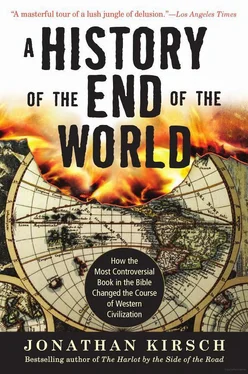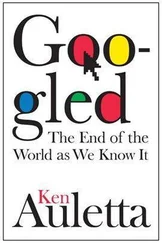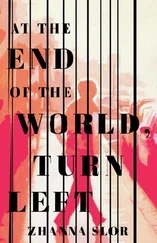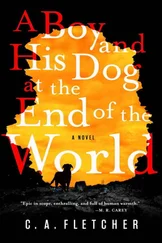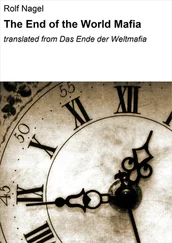“If you are a believer, chapters 4 and 5 of Revelation describe what you will be experiencing in heaven,” Lindsey writes. “Talk about mind expansion drugs!” 43
Fatefully, Lindsey is unable to resist the same temptation that has resulted in the embarrassment of every previous doomsayer from Montanus to Father Miller—the cardinal sin of date setting. The countdown clock for doomsday, Lindsey argues, began with the establishment of the modern state of Israel, and he interprets various fragments of biblical text to confirm that the end will come within the lifetime of the generation that witnessed its rebirth in 1948. On the assumption that a generation is equivalent to forty years, Lindsey suggests in The Late Great Planet Earth, first published in 1970, that the Rapture will take place in 1981, followed by seven years of persecution under the Antichrist and then, in 1988, the battle of Armageddon and the second coming of Jesus Christ.
Lindsey, of course, was proven wrong. As the year 1981 approached and the Rapture seemed no nearer, he rechecked his end-time calculations and offered a slightly revised schedule in The 1980s: Countdown to Armageddon (1980). After the collapse of the Soviet bloc in the early 1990s, however, he was inspired to offer a new end-time scenario in Planet Earth 2000 A.D. (1994): Islamic fundamentalism rather than the Red Army will be the final adversary of Jesus Christ at the battle of Armageddon, although he insists that “the ‘collapse’ of Communism is part of a masterful game of deceit engineered by Mikhail Gorbachev and the Soviet KGB.” 44Still later, Lindsey offered another insight into the workings of Satan: UFO sightings, he argued, are “deceptive ruses by demons, who will soon stage a massive UFO landing to mislead earthlings into believing in life on other planets.” 45
Lindsey himself, like Father Miller, remained cheerful and unchastened even though his prophecies proved to be wrong and his revisionist works failed to achieve the same stellar sales that had been racked up by The Late Great Planet Earth. As it turned out, Lindsey had achieved something new, significant, and enduring in spite of the manifest failure of his prophecies: he played a crucial role in leveraging the apocalyptic idea out of the fundamentalist churches and into the mainstream of American civilization. Among his 20 million readers, for example, was a man who would take the book of Revelation out of the tent meeting and into the White House.
Revelation achieved its first penetration into American politics with the unlikely rise of Ronald Reagan, first as governor of California and later as president of the United States. Raised in a church with roots that reached all the way back to the era of the Second Great Awakening—and reportedly an early reader of The Late Great Planet Earth— Reagan was perhaps the first national figure outside of fundamentalist circles to openly and unapologetically affirm his belief in the imminent fulfillment of Bible prophecy.
“Apparently never in history have so many of the prophecies come true in such a relatively short time,” said Ronald Reagan, then serving as governor of California, in an interview that appeared in 1968 in Christian Life magazine. 46And he was even more forthcoming at a political dinner in Sacramento in 1971 when he commented on the significance of a recent coup in Libya: “That’s a sign that the day of Armageddon isn’t far off,” declared Reagan. “Everything’s falling into place. It can’t be long now.” 47
Reagan, in fact, was able to cite chapter and verse to support his prediction. The incident in Libya apparently put him in mind of a Sunday-school lesson on the apocalyptic prophecies of the Hebrew Bible: “For the day is near, even the day of the Lord is near,” goes a passage in the book of Ezekiel. “Ethiopia, and Libya, and Lydia, and all the mingled people…shall fall with them by the sword.” And Reagan, apparently inspired by the sight of waiters igniting bowls of cherries jubilee in the darkened dining room, was mindful of God’s vow to bring down on Gog, the biblical enemy of Israel, “great hailstones, fire, and brimstone.” 48Reagan alluded to these passages during his table talk and concluded: “That must mean they’ll be destroyed by nuclear weapons.” 49
Reagan carried those Sunday-school lessons all the way to Washington. “We may be the generation that sees Armageddon,” he told televangelist Jim Bakker in 1980. 50“You know, I turn back to your ancient prophets in the Old Testament and the signs foretelling Armageddon, and I find myself wondering if we’re the generation that’s going to see that come about,” he told a Jewish lobbyist in 1983. “I don’t know if you’ve noted any of those prophecies lately, but believe me, they certainly described the times we’re going through.” 51
Reagan surrounded himself in the White House with men who shared the same beliefs. “I have read the Book of Revelation,” affirmed Caspar Weinberger, his secretary of defense, “and yes, I believe the world is going to end—by an act of God, I hope—but every day I think that time is running out.” And James Watts, Reagan’s interior secretary, demurred to a question about his plans for protecting the environment for the benefit of future generations by invoking the Second Coming: “I do not know how many future generations we can count on before the Lord returns.” 52
Reagan appears to have been a convinced reader of The Late Great Planet Earth. “Every one of Lindsey’s proposals for domestic and foreign policy,” insists Stephen D. O’Leary, “was part of Reagan’s campaign platform.” 53To hear Lindsey himself tell it, Reagan was eager to win over the American military establishment to apocalyptic true belief. With the president’s blessing, Lindsey asserts, he was invited to brief Pentagon war planners on the divine implications of nuclear combat with the Soviet Union. And Reagan invited televangelist Jerry Falwell, another prominent and outspoken apocalyptic preacher, to attend briefings of the National Security Council and deliver the same sermon.
Such notions were wholly unremarkable in the fundamentalist churches of America—and they reached an even wider audience through the radio and television broadcasts of various apocalyptic preachers, both famous and obscure—but they were deeply unnerving in the mind and mouth of a man who is accompanied wherever he goes by the launch codes of the American nuclear arsenal. If the president of the United States is a true believer who is convinced that “the day of Armageddon isn’t far off,” would he not be tempted to take it upon himself to rain fire and brimstone down on the latest enemy to be seen as the Antichrist?
That troubling question was raised by network correspondent Marvin Kalb during the televised debates of the 1984 presidential campaign. Nancy Reagan could be heard to mutter “Oh no!” in the background, but the president himself was prepared with a reasonable and even statesmanlike answer. Reagan conceded that he had a “philosophical” interest in the biblical prophecies about the battle of Armageddon, and he argued that “a number of theologians” had suggested that “the prophecies are coming together that portend that.” But he concluded that it was impossible to know whether Armageddon “is a thousand years away or day after tomorrow.” And he insisted that he “never seriously warned and said we must plan according to Armageddon.” 54
Still, the issue did not go away. The New York Times editorialized on the peril posed by the “Armageddonist” advisers in the inner circle of the Reagan administration. Self-styled “gonzo” journalist Hunter S. Thompson, noting that “the president is very keen on the Book of Revelation” and pointing out a few of the weirder sights that are described in the biblical text, observed that “a lot of acid freaks have been taken away in white jackets with extremely long sleeves for seeing things like that.” 55On a more sober note, a committee of one hundred clergy joined in imploring the president to “disavow the dogma that nuclear holocaust is foreordained in the Bible.” 56
Читать дальше
